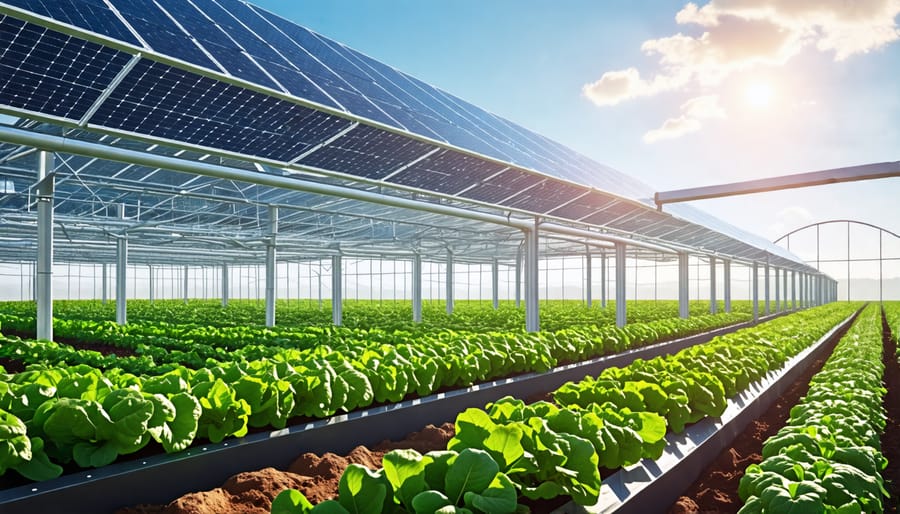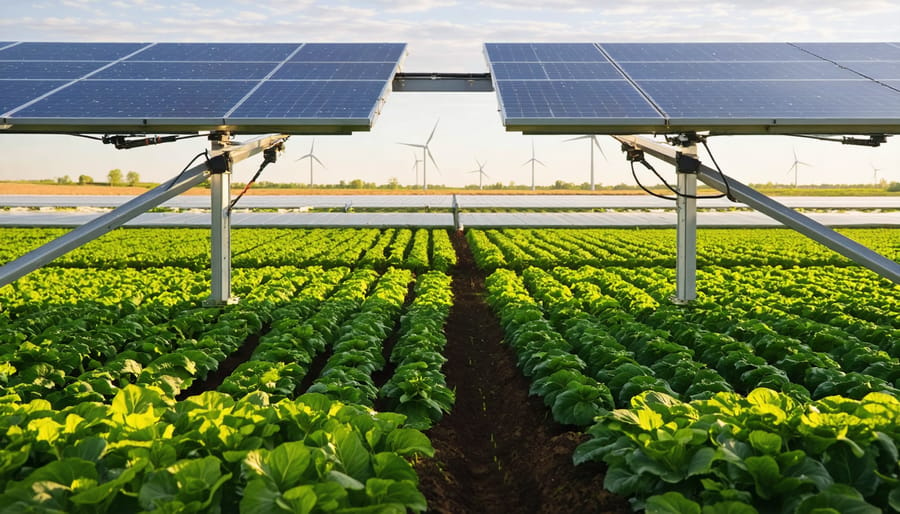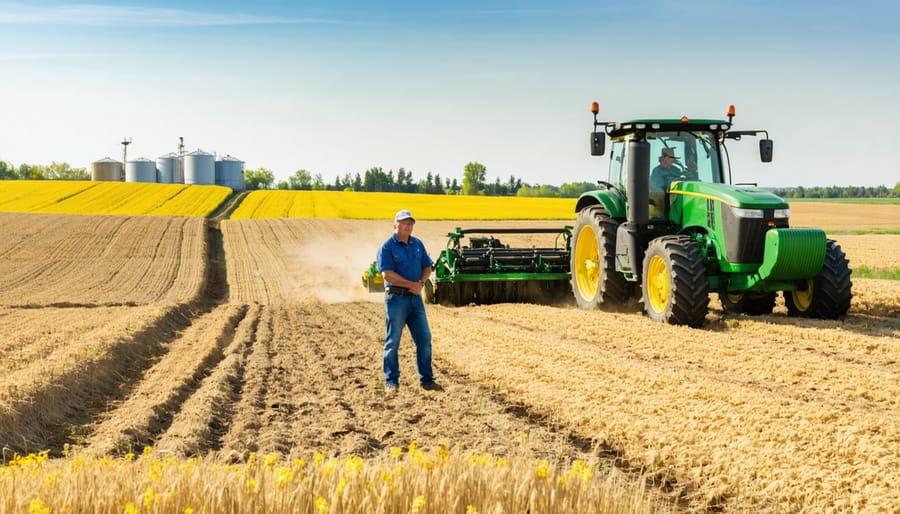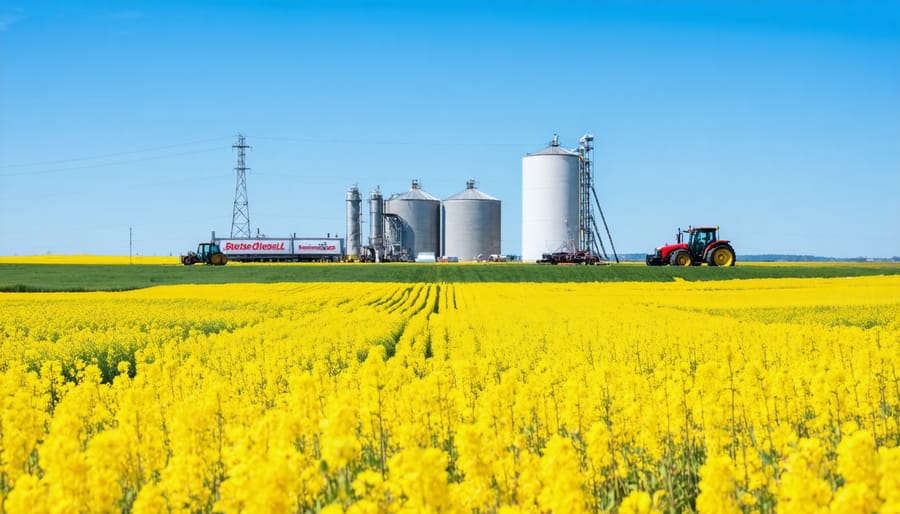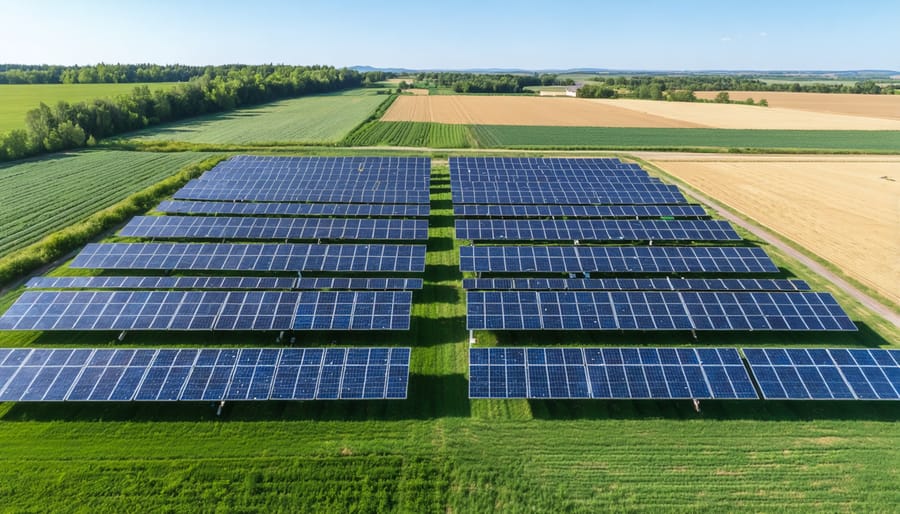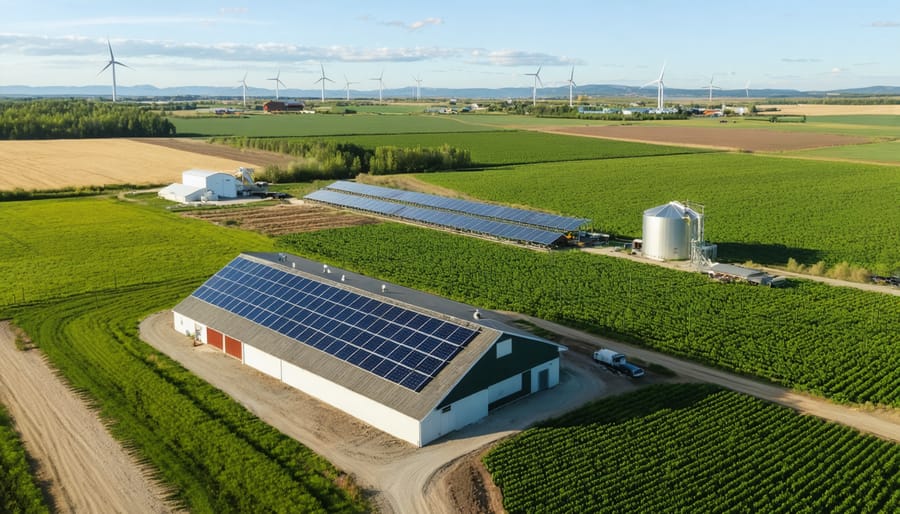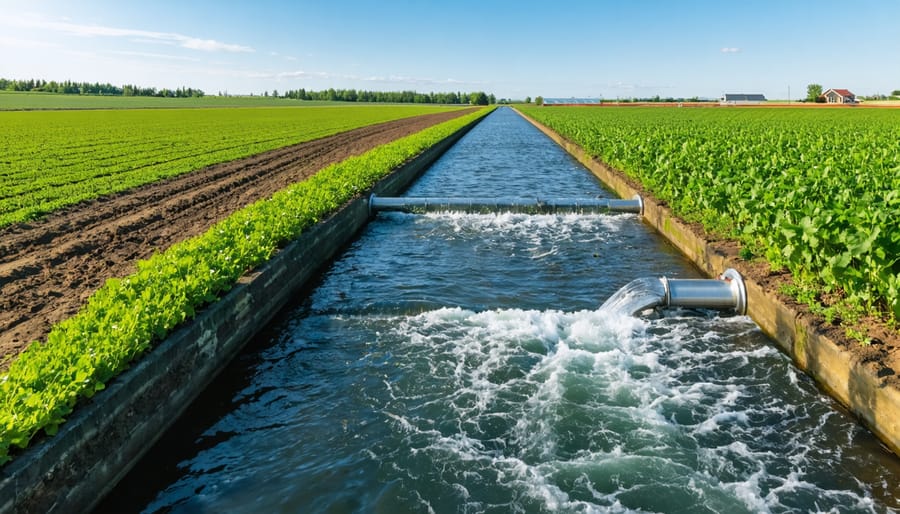Harness the power of agrivoltaics to revolutionize your greenhouse operations. This innovative approach combines solar energy generation with crop production, offering a sustainable solution for modern agriculture. By integrating photovoltaic panels into your greenhouse design, you can generate clean electricity while optimizing plant growth and reducing operational costs. Agrivoltaics not only enhances the efficiency of your greenhouse but also contributes to a greener future for Canadian agriculture. Discover how this cutting-edge technology can transform your farm and join the growing community of forward-thinking farmers embracing agrivoltaics.
How Agrivoltaic Greenhouses Work
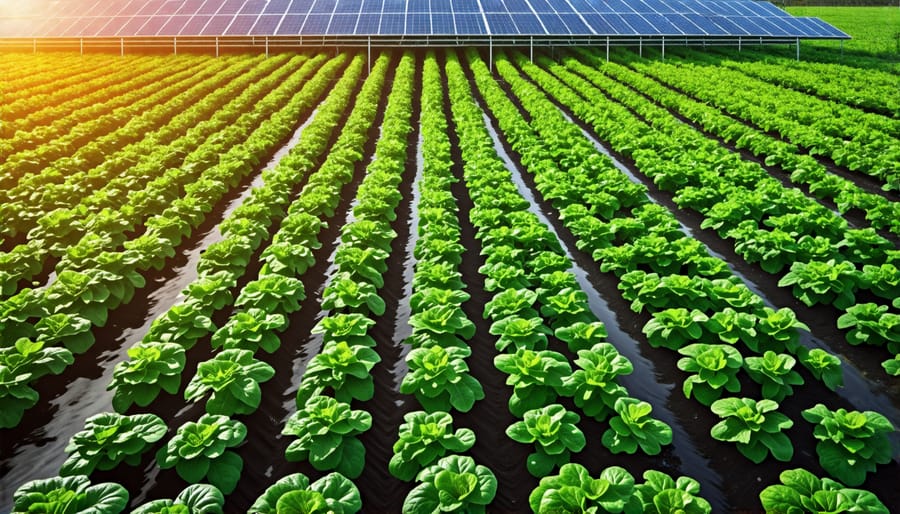
Solar Panel Configuration
In agrivoltaic greenhouses, solar panels are strategically positioned to optimize both energy generation and light transmission for crops. Typically, semi-transparent or translucent photovoltaic panels are installed on the roof, allowing filtered sunlight to reach the plants below. The panels are spaced apart to create a “checkerboard” pattern, balancing shade and light exposure. This configuration ensures that crops receive sufficient light for photosynthesis while the panels generate renewable energy. The optimal panel arrangement depends on factors such as the greenhouse’s location, crop type, and energy requirements. Some systems even use adjustable panels that can be tilted or moved to adapt to changing light conditions throughout the day or season. By carefully designing the solar panel layout, farmers can harness the power of the sun to produce both clean energy and healthy crops, making their operations more sustainable and self-sufficient.
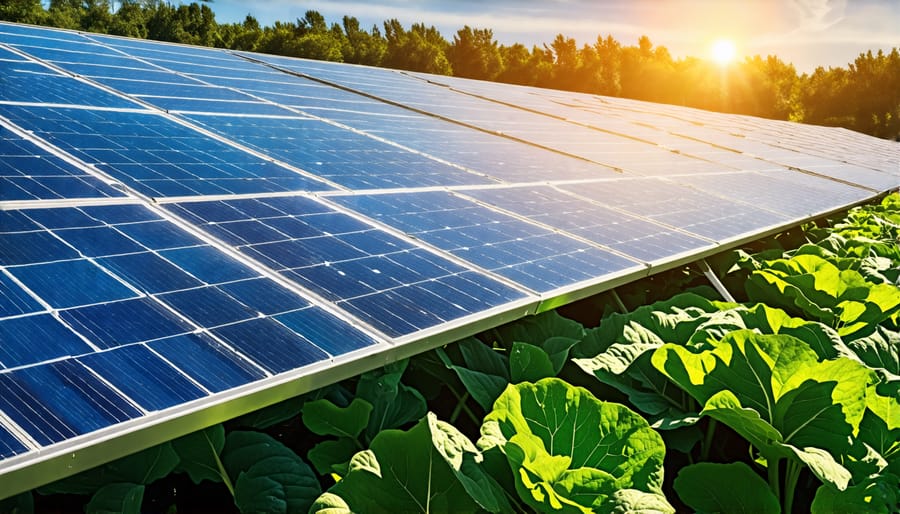
Crop Selection and Placement
When selecting crops for an agrivoltaic greenhouse, it’s essential to consider plants that thrive in partial shade and can tolerate the microclimate created by the solar panels. Leafy greens like lettuce, spinach, and kale are excellent choices, as they require less direct sunlight and can benefit from the cooler temperatures under the panels. Herbs such as basil, mint, and parsley are also well-suited for agrivoltaics due to their shade tolerance and compact growth habits.
Strategic crop placement is key to optimizing yields and ensuring all plants receive adequate light. Taller crops like tomatoes or cucumbers can be planted in the center of the greenhouse, where they can access more direct sunlight passing between the solar panels. Lower-growing crops and those with lower light requirements should be placed in the areas with more shade. By carefully selecting and arranging crops based on their light needs, farmers can maximize the efficiency and productivity of their agrivoltaic greenhouse.
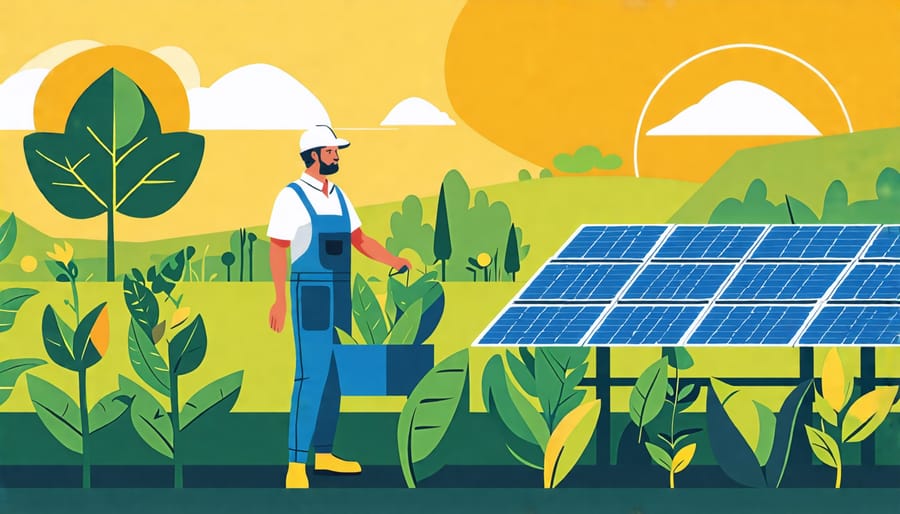
Benefits for Farmers and the Environment
Supplemental Income from Solar Power
Agrivoltaic systems offer farmers an attractive opportunity to generate supplemental income through the production of solar power. By installing solar panels on their greenhouses, growers can sell excess electricity back to the grid, providing a reliable source of renewable energy and diversifying their revenue streams. This additional income can help offset operational costs, improve financial stability, and support future investments in sustainable agriculture practices. As government incentives and rebates for solar power continue to evolve, the potential financial benefits of agrivoltaics become even more appealing for Canadian farmers looking to embrace innovative solutions.
Enhanced Growing Conditions
Solar panels installed above crops create a microclimate that benefits certain plants. By providing partial shade, the panels reduce heat stress and evapotranspiration, which can improve crop yields and quality. Studies at the University of Guelph found that shade-loving crops like lettuce, kale, and herbs thrived under solar panels, with some varieties producing up to 50% more yield. The panels also protect crops from heavy rain, hail, and frost damage. Additionally, the cooler microclimate extends the growing season, allowing farmers to potentially double-crop and increase annual yields. These enhanced conditions make agrivoltaics an attractive option for Canadian growers seeking to optimize production while generating clean energy.
Water Conservation
Agrivoltaics can significantly reduce water evaporation and irrigation needs in greenhouses. By providing shade, the solar panels help maintain cooler temperatures and higher humidity levels, which decreases the amount of water lost through evaporation. Studies have shown that agrivoltaic systems can reduce evaporation rates by up to 50% compared to traditional greenhouses. This translates to lower water consumption and more efficient use of this precious resource. Additionally, the electricity generated by the solar panels can power automated irrigation systems, ensuring precise watering and further optimizing water usage. For Canadian farmers facing increasing water scarcity and rising costs, agrivoltaics offer a promising solution for conserving water while maintaining crop productivity.
Climate Change Mitigation
Agrivoltaic greenhouses offer a promising solution for reducing agriculture’s carbon footprint. By generating clean solar energy on-site, farmers can decrease reliance on fossil fuels and lower greenhouse gas emissions. The shade provided by solar panels also reduces water evaporation, leading to more efficient irrigation and water conservation. Additionally, the cooler microclimate under the panels can improve crop resilience to heat stress, potentially reducing crop failures and the need for energy-intensive replanting. As climate change poses growing challenges for Canadian agriculture, agrivoltaics represents a proactive approach to mitigating its impacts while enhancing farm sustainability and profitability.
Agrivoltaics in Action: Canadian Case Studies
Across Canada, innovative farmers are embracing agrivoltaic greenhouse technology to enhance crop production while generating clean energy. In Alberta, several pioneering projects showcase the potential of this sustainable approach.
At Green Valley Farms near Lethbridge, owner Mark Thompson has integrated solar panels into his 10-acre greenhouse. “By using agrivoltaics, we’ve been able to reduce our energy costs by 40% while maintaining optimal growing conditions for our tomatoes and cucumbers,” Thompson explains. “It’s a win-win situation.”
Similarly, Sunshine Acres in Taber has successfully implemented agrivoltaic technology in their 5-acre pepper greenhouse. “We were initially concerned about shading affecting our yields,” admits owner Sarah Johnson, “but with the right panel configuration and spacing, we’ve actually seen an improvement in crop quality and reduced water usage.”
Experts at the University of Alberta are studying the benefits of agrivoltaic greenhouses in the province. Dr. Emily Chen, a researcher in the Department of Renewable Resources, notes, “Our findings suggest that agrivoltaics can help mitigate the impacts of climate change on agriculture by providing shade during extreme heat events and extending the growing season.”
The Alberta government has recognized the potential of agrivoltaics and offers grants to support farmers in adopting this technology. “We believe that agrivoltaic greenhouses are a key component of building a more resilient and sustainable agricultural sector in Alberta,” states Minister of Agriculture and Forestry, David Turner.
As more farmers in Alberta and across Canada embrace agrivoltaics, the benefits are becoming increasingly evident. Not only do these systems contribute to clean energy production and reduced greenhouse gas emissions, but they also help farmers adapt to the challenges posed by climate change. With ongoing research and support, agrivoltaic greenhouses are poised to play a significant role in shaping the future of Canadian agriculture.
Getting Started with Agrivoltaics
Assessing Your Farm’s Potential
Before investing in agrivoltaics, assess your farm’s suitability for this innovative system. Consider factors such as available land, crop types, and energy needs. Conduct a site analysis to determine the optimal location for solar panels, ensuring they won’t interfere with existing operations. Evaluate your current energy usage and costs to estimate potential savings. Consult with local agricultural experts and solar installers to discuss the feasibility and benefits of agrivoltaics for your specific farm. Reach out to other farmers who have successfully implemented agrivoltaics to learn from their experiences and gain valuable insights. By thoroughly assessing your farm’s potential for agrivoltaics, you can make an informed decision about whether this sustainable technology is the right fit for your operation. Remember, while agrivoltaics can offer numerous benefits, it’s essential to carefully consider your unique circumstances and goals before making the transition.
Connecting with Experts and Support
Connecting with experts and professionals who have experience with agrivoltaic systems can provide valuable guidance and support as you explore and implement this technology. Organizations like the Canadian Agrivoltaic Learning Network and the Alberta Greenhouse Growers Association offer workshops, webinars, and networking opportunities to connect with fellow farmers and industry leaders. Consulting with agrivoltaic specialists can help you assess the feasibility of integrating solar panels into your specific greenhouse design, optimize crop selection, and navigate the installation process. Engaging with these resources and the agrivoltaic community can empower you to make informed decisions and successfully adopt this innovative approach to sustainable agriculture.
Conclusion
In conclusion, agrivoltaic greenhouses offer a promising solution for Canadian farmers looking to enhance their crop yields, reduce energy costs, and contribute to a more sustainable future. By leveraging the power of solar energy and optimizing growing conditions, agrivoltaics can help address the challenges posed by climate change and resource scarcity. The success stories from early adopters across Canada demonstrate the viability and potential of this innovative approach.
As we move forward, it is crucial for farmers, researchers, and policymakers to collaborate and invest in the development and implementation of agrivoltaic systems. By sharing knowledge, resources, and best practices, we can accelerate the transition to a more resilient and prosperous agricultural sector. The future of farming lies in our ability to adapt, innovate, and embrace sustainable technologies like agrivoltaics.
We encourage all farmers, particularly those in the Alberta region, to explore the possibilities of agrivoltaic greenhouses and consider how they can integrate this technology into their operations. Together, we can build a thriving agricultural community that not only feeds our nation but also safeguards our environment for generations to come.

